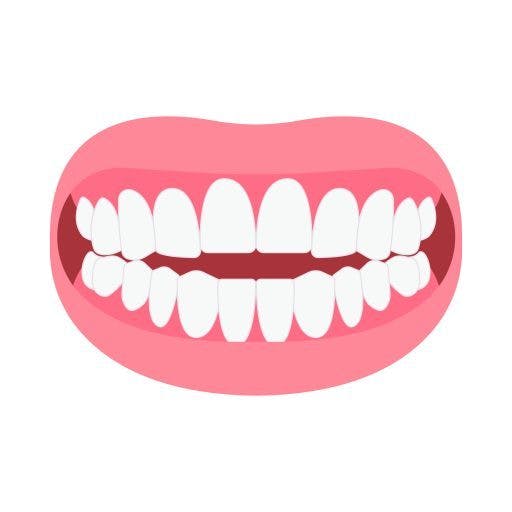Teeth alignment goes beyond aesthetics. It prevents unnecessary wear and tear on your teeth, jaw, and gums. The ideal bite has the upper teeth sitting slightly before your lower teeth. If there is a visible gap between the top and bottom rows, you may have an open bite.
Thankfully, dentists can correct this condition to keep you from encountering difficulties in chewing or speaking. Read on to learn about the causes, risks, and available treatment options.
What is an open bite?
An open bite is a dental misalignment (malocclusion) where a gap remains between your upper and lower teeth when your mouth is closed. Often, the front teeth may jut outward, creating the gap. Ideally, your teeth should overlap slightly to ensure proper function.
Curious if you have an open bite? Take this online smile assessment today.
Causes of an open bite

Certain oral habits can cause misaligned teeth. Here are the common ones.
Pacifier use and thumb-sucking
Prolonged pacifier use and finger- or thumb-sucking can cause the top front teeth to protrude, tip forward, and form a gap over the lower teeth. The Australian Society of Orthodontists says the shape of the opening may even correspond to the child’s finger or thumb. Thus, dentists recommend discontinuing pacifier use by age three.
Tongue habits
Dentists and speech therapists also attribute open bite to tongue thrusting, a habit where the muscle pushes between the teeth when speaking or swallowing. Improper tongue positioning – when it rests in a forward posture against your teeth – can cause breathing difficulties and jaw pain.
Prevent these issues by resting your tongue against the roof of the mouth when at rest. Keep your teeth slightly apart and your lips closed.
Mouth breathing
Studies have suggested that mouth breathers are at risk of developing malocclusions. For example, in a study published in Frontiers in Public Health, researchers found that those who breathed through their mouths exhibited an anterior open bite and a crossbite (when your top teeth don’t fit over your bottom teeth). Another study found that kids with enlarged adenoids (tissues in the back of the nose) were prone to mouth breathing and the presence of an open bite.
Genetics
Studies show that genetics may be responsible for up to 60% of dental and facial features, including malocclusions. Recent evidence suggests some genes can cause jawbones to grow irregularly, affecting the shape and appearance of the face and leading to open bites.
However, the impact of genetics alone may not be as significant as the other issues above. A combination of these factors can certainly contribute to the development of misaligned teeth.
Types of open bite
When dentists examine your bite, they check how your top and bottom teeth fit together. They look from the front and the side and into your open mouth.
When the top and bottom rows of your teeth don’t fit, a gap occurs, creating a misalignment of the teeth. The gap’s location is the deciding factor in the two types of open bite, as described by the Australian Society of Orthodontics.
Anterior open bite

You can spot the signs of an anterior open bite (AOB) when you smile or clench your jaw. The top and bottom row of teeth do not touch even when the mouth is closed, but the teeth in the back do when you bite down.
Posterior open bite

With a posterior open bite (POB), you won’t notice an opening between the front upper and lower teeth. Dentists can only confirm it’s a POB when they look at your back molars and see them touching.
Other signs that indicate you may have an AOB or POB include:
- Difficulty chewing or biting
- Mouth breathing
- Crooked or overcrowded front teeth
- Tongue poking out while speaking or swallowing
- Excessive tooth wear
Risks of having an open bite

How serious is an open bite? If left undiagnosed, it can put your oral health at risk, affecting how you talk, eat, and feel. In the long run, it can also cause complications for your overall health.
1. Tooth damage
An AOB can make eating with the front teeth difficult. So, your back teeth compensate, putting additional stress on your mouth. The damage includes worn and chipped teeth, tooth fractures, and gum problems.
2. Periodontal disease
The American Academy of Medical Orthodontics explains that people with an open bite often breathe through their mouths, which can cause dryness. Such a condition serves as a breeding ground for bacteria, putting you at risk of inflammation and gum diseases. Additionally, a misaligned bite results in uneven distribution of biting force, leading to problems like tooth loss.
3. Temporomandibular dysfunction
Abnormal alignment can strain the two joints that connect to the lower jawbone of the skull. The temporomandibular joint (TMJ) enable jaw movements when you talk, chew, and yawn. Repeated undue force on the joints can lead to temporomandibular dysfunction (TMD). Australian Journal of General Practice says symptoms of TMD include:
- Jaw pain
- Headaches
- Facial and neck pain
- Clicking or popping sounds during jaw movements
- Jaws “lock” when opening or closing the mouth
- Bruxism or teeth grinding
4. Speech problems
In a study published in Face Journal, a speech pathologist examined individuals with AOB and discovered they had speech issues, particularly with consonant sounds.
The research explained that the production of consonant sounds relies on the airflow against oral structures, including the tongue and teeth. When the jaw is not in the correct position or shape, it can lead to speech problems, such as lisping or difficulty pronouncing certain words.
5. Digestive health issues
Proper chewing is essential to break down food into smaller pieces, facilitating smooth passage through the oesophagus and ensuring optimal digestion. However, individuals with a posterior open bite may experience chewing difficulties, leading to digestive issues like bloating. Consequently, your body may struggle to absorb nutrients from your food.
Treatment for open bite
Book a dental appointment with your orthodontist when you notice a gap between your upper and lower teeth, even when your mouth is closed. Your dental health provider may start your treatment by using X-rays, 3D imaging, and oral examinations to assess the severity of your open bite.
Treatments can include behaviour modification therapy, commonly recommended for young children and teens to correct oral habits, or jaw surgery for severe cases. Dentists can also prescribe mechanical treatment, such as traditional braces or invisible aligners like ClearCorrect. These orthodontic appliances help adjust the position of the front and bottom teeth to achieve the ideal bite.
Dentists can correct an open bite at any age, but management becomes complicated with adult teeth. If you suspect teeth alignment problems, consult a professional immediately. Everyone deserves a healthy smile that makes you feel confident inside and out.
References:
Australia, O. (2022, June 10). How Are Teeth Supposed to Sit for a Perfect Bite? Orthodontics Australia.
Australia, O. (2023, March 8). Open Bite Problems & Orthodontic Treatment. Orthodontics Australia.
Gutierrez, D. S. (2023, March 19). Thumb Sucking. StatPearls – NCBI Bookshelf.
Huang, W., Shan, B., Ang, B. S., Ko, J. S., Bloomstein, R. D., & Cangialosi, T. J. (2020). Review of Etiology of Posterior Open Bite: Is There a Possible Genetic Cause?. Clinical, Cosmetic and Investigational Dentistry, Volume 12, 233–240.
Keyser, M., Lathrop, H., Jhingree, S., Giduz, N., Bocklage, C., Couldwell, S. M., Oliver, S., Moss, K., Frazier-Bowers, S. A., Phillips, C., Turvey, T. A., Blakey, G. H., White, R., Zajac, D. J., Mielke, J., & Jacox, L. A. (2022). Impacts of Skeletal Anterior Open Bite Malocclusion on Speech. FACE, 3(2), 339–349.
Kina, J. R., Kina, J., Kina, M., & Kina, E. F. U. (2016). Open Bite Malocclusion as potential Predisposing Risk Factor to Promote Periodontal Disease. Journal of Orthodontics & Endodontics, 02(03).
Lin, L., Zhao, T., Qin, D., Hua, F., & He, H. (2022). The impact of mouth breathing on dentofacial development: A concise review. Frontiers in Public Health, 10.
Paolantonio, E. G., Ludovici, N., Saccomanno, S., La Torre, G., & Grippaudo, C. (2019). Association between oral habits, mouth breathing and malocclusion in Italian preschoolers. European Journal of Paediatric Dentistry, Vol. 20/3-2019.
Rohit, K. (2018). Open bite malocclusion: An overview. Journal of Oral Health and Craniofacial Science, 011–020.
Temporomandibular dysfunction. (n.d.). Australian Journal of General Practice.
Thumb sucking and concerns – Australian Society of Orthodontists. (n.d.).
Types of orthodontic problems you should look out for in your kids – Australian Society of Orthodontists. (n.d.).



